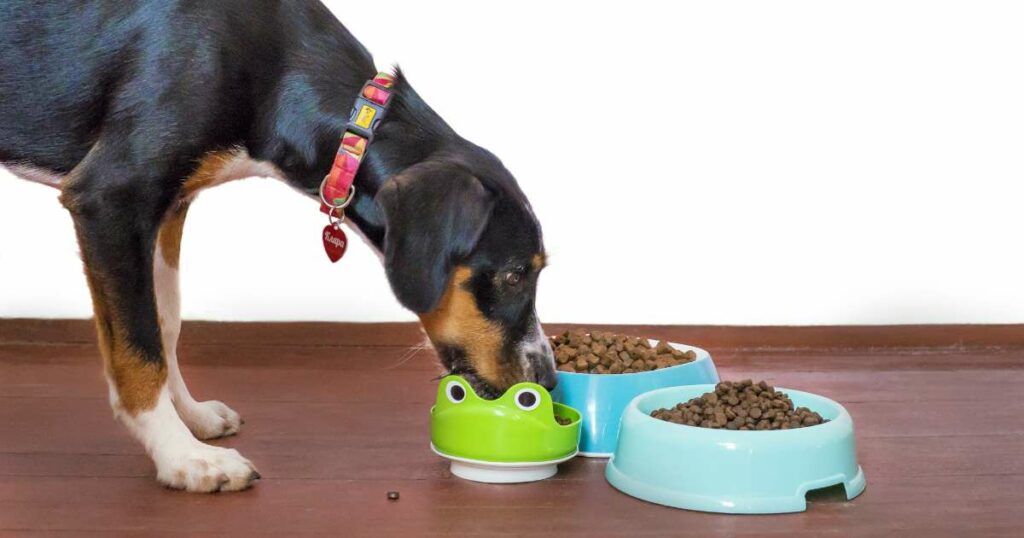To ensure your dog’s overall health and well-being, be sure to feed them the right amount of nutritious food. Giving them Super healthy food is very important. To know how and what to feed your dog, you must comprehend the nutritional requirements of dogs and how these requirements have changed as a result of biological evolution.
However, it can be challenging to determine what essentially amounts to a dog meal’s nutritional value and balance given the variety of dog food formulas and brands available.
Verify the AAFCO Criteria

AAFCO, the Association of American Feed Control Officials, has created nutritional recommendations. The general guidelines provided by AAFCO for the nutritional makeup of commercial pet meals are stated there. Make sure the dog food you are feeding your dog complies with the AAFCO standards.
Corroborate that the AAFCO criteria are met by the food you feed your canine.
Keep in mind that these are only recommendations, and your dog may need more or less depending on his specific medical needs. For more information on the specific nutrients that your dog may require, talk to your veterinarian.
AAFCO Label Requirements:
- Product and brand names
- Ingredient declaration
- The name of the species for whom the pet food is intended
- Quality assertion
- Directions for Feeding
- Identification of the manufacturer or distributor
- Assurance of analysis the percentage of each nutrient present in the food is listed here. Depending on the nutrient, it must be administered in a specific order, in predetermined amounts, and at a minimum or maximum.
- The nutritive adequacy statement states that this” indicates that the feed is complete and balanced for a particular life stage, similar as growth, reduplication, adult conservation, or a blend of these, or is suited for intermittent or supplemental feeding only.”
What Nutritional Requirements For Dogs?
Water, proteins, lipids, carbs, minerals, and vitamins cover the six fundamental nutrients. These essential nutrients, which are crucial to all of the body’s fundamental functions, must be regularly consumed by the dog.
For many foods, the minimal dietary need has been defined. Some nutrients have known maximum acceptable doses, and the effects of toxicity have been proven.
Considers Some Factors Before Choosing Food
Dogs’ energy needs might vary depending on a number of things. In order to support your dog’s everyday lifestyle, it’s crucial to satisfy its unique energy needs. Some of these things are:
- According to age groups (young, middle, and older)
- Medical and behavioral conditions
- Activity level
- Growth
- Reproduction (intact vs. altered)
- Breed
Choose The Best Dog Food
In the end, it is up to you to pick the fantastic canine meals for your pet. You are the one who sees your canine on an ordinary foundation due to the fact you are the owner. Your dog’s meals is likely doing simply high-quality if they have firm, wholesome stools, are lively and fit, and have a proper appetite.
Throughout this procedure, your veterinarian is a beneficial aid for you. They have get admission to lookup and assets that proprietors do not, making them greater educated about pet vitamin than the normal owner.
Your veterinarian can assist you in decreasing your chances and ought to be extra than delighted to aid you in finding the options to your inquiries related to the foods for your dog. Asking your vet for advice on dog food selection is the best thing to do.
Consider These Things:
- Give your dog high quality food.
- Choose a low-calorie diet. Most older, indoor, neutered, or spayed dogs require little energy. Less than 350 calories per cup should be the recommended number of calories in your dog’s diet. The recommended serving size is minimal (and unsatisfactory!) if your dog weighs 20 pounds and your dog food has 500 calories per cup. Even a few more kibbles from high-calorie diets can significantly contribute to weight gain, which is a worsening situation.
- Make sure your dog does not suffering from diabetes. There is multiple option of diabetic dog food.
- Choose diets made up of recognizable, whole foods. Find another diet if you are not familiar with utmost of the listed constituents.
Dog Food For Small And Large Dog Breed
Large dog breeds and small dog breeds have different nutritional needs.
Large- strain tykes may bear large- strain canine food with distinct nutrient balances to support musculoskeletal health, especially as puppies because they’re more prone to musculoskeletal issues than lower types.
On the other hand, small-breed dogs have unique nutritional needs that can be met by small-breed dog food but can choke on large-sized kibble.
Feeding Your Puppy

6–12 Weeks Puppy
Puppies should be fed puppy food, a diet designed specifically to meet the nutrient requirements for healthy development. Giving your puppy adult food will deny it vital nutrients. Four feedings per day are usually enough to meet nutritional needs. Large breeds should be fed unmoistened dry food by 12 or 13 weeks, and vice versa.
3-6 months Puppy
Reduce feedings from four to three per day somewhere during this time. A puppy should start to lose her potbelly and pudginess around the age of 12 weeks. Continue feeding her puppy-size quantities if she is still wiggly at this age until her body type develops.
6–12 months Puppy
Feeding should start at 6–12 months. After the procedure, the transition from nutrient-rich puppy food to adult maintenance food is necessary because spaying or neutering somewhat reduces the amount of energy needed. Smaller breeds can transition at 7 to 9 months, whereas larger breeds need to wait until 12, 13, or even 14 months. It’s better to be safe and feed a puppy food for a little longer than not at all.
After the age of one, most owners give their adult dogs two meals a day.
Feeding your Senior Dog

Your dog requires a diet that will fulfill its more developed needs as they become older. Dogs are typically regarded as “elderly” or “mature” when they have lived around half their expected lifespan. For little dogs, this is roughly 7 years, whereas, for larger dogs, it is 5 years.
Additionally, there are diets for senior dogs that are frequently created to be provided throughout their final few years of life.
Diets for senior dogs are easier to digest and contain a balance of nutrients that can help make up for some of the changes that can occur as a dog ages. This may entail supporting their joints and lowering nutrient levels that their body may find difficult to absorb as they age.
Feeding your Adult Dog

Adult dog diets are designed to keep your dog at a healthy weight and size once they reach adulthood. Look for an adult dog diet that will fit your dog’s specific needs and way of life from among the many that are offered.
There are diets made specifically for working dogs or dogs who have undergone neutering, for instance. If your dog needs to lose weight or has certain medical concerns, you might also need to feed them a certain diet. Ask your veterinarian for advice if you’re unsure of which diet is best for your mature dog.
I hope this information will be useful for you
